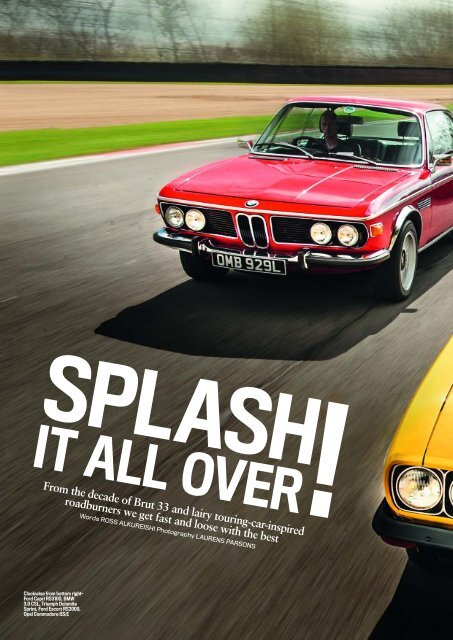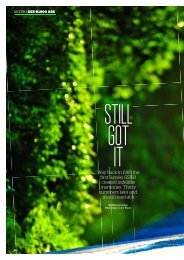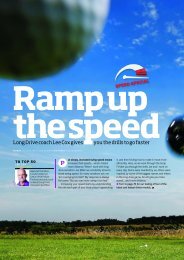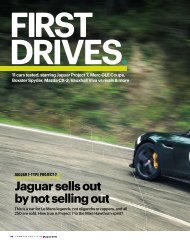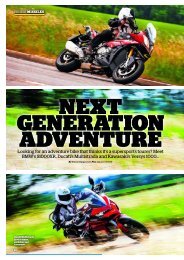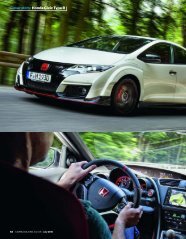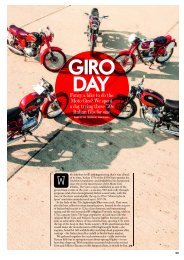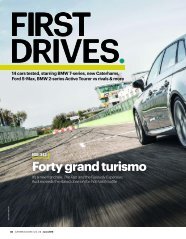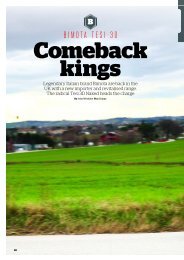Create successful ePaper yourself
Turn your PDF publications into a flip-book with our unique Google optimized e-Paper software.
SPLASHIT ALL OVER!From the decade of Brut 33 and lairy touring-car-inspiredroadburners we get fast and loose with the bestWords ROSS ALKUREISHI Photography LAURENS PARSONS46Clockwise from bottom right–Ford Capri RS3100, BMW3.0 CSL, Triumph DolomiteSprint, Ford Escort RS2000,Opel Commodore GS/E
SEVENTIES TOURING CAR SHOWDOWN47
As the European Touring Car world moved into abrave new decade, the old-fashioned notion of takingstock dealer cars and giving them a bit of a tweakbefore heading trackside hadn’t just subsided, it’dbeen obliterated.The new trend for muscular wheelarches,aerodynamic appendages and ever-widening rubbermeant tin-tops adopted appearances of track warriors readyingthemselves for battle, while only nominally resembling the cars thatwe could buy.Under the skin this increased exponentially as an engineeringspace-race transformed their respective semi-humble originsinto potent portents of mechanical doom, with fearsome poweroutputs that the previous generation of gentlemen racers couldonly have dreamed of.Yet cars are products of their time and, as the world lurched fromfuel shortage to full-on industrial crisis and global unrest, bothworks teams and privateers would have to ride a wild zeitgeist, onethat crushed dreams yet brought opportunity in equal measure.Now it’s our turn to return to that tumultuous time, as we takethe roadgoing versions of five of the era’s finest competitors for aplay at Brands Hatch. Motor sport fans could be forgiven forrecalling only two tribes going to war, and yes the big boys are herewith the 3.0 BMW CSL squaring up to the Ford RS3100 oncemore, but to that add Ford Escort MkI, Opel Commodore andTriumph Dolomite Sprint, as our quintet play for the ultimate prize.FORD CAPRI RS3100The Blue Oval’s ‘European Mustang’ was never meant to go racing.As a study in fashion, if not precision engineering, the Ford CapriMkI did exactly what it set out to do and conquered the hearts ofeveryman drivers. Engineers though, and especially those of a motorsport bent, just can’t help themselves; surely that chassis – a fusionof Cortina MkII/Corsair and Escort design ideas – had potential?Cue the RS2600, the first Capri homologation special. Despitebeing a joint venture of the Advanced Vehicle Operation at Aveleyand Ford-Germany, because of the isolationist nature of production– German Capris made in Germany with German engines, with theopposite true for British versions – it was only ever destined to beleft-hand drive and for mainland Europe. The fuel-injected 2.7-litreCologne V6 produced a spirited 150bhp, while the chassis sportedlowered suspension, Bilstein dampers and single-leaf rear springs.Amazingly its two-door coupé body and cramped interior, by wayof some pretty Jackanory jiggery-pokery, was passed off as agenuine four-seater – Group 2 saloon car racing, here we come. Itsimpact was immediate. The new Weslake-tuned lightweight racersstormed through the 1971 European Touring Car Championshipseason, destroying the field, with Dieter Glemser securing theDrivers’ Championship. The following year Jochen Mass repeatedthe trick, but there would be no duplication in 1973, because thearrival of arch rival BMW’s bewinged 3.0 CSL ‘Batmobiles’ provedvirtually unbeatable. The direct result of Munich’s intervention this48
FORD CAPRI RS3100 TOURING CARSV6 pumps out ameaty 148bhp; racecars gave 420bhpMammoth ducktailspoiler channelsracetrack vibesstraight to the roadInterior just begsfor some B&Hsmoke and youtime prompted a decidedly British response, and today we’re drivingthe result – Wayne Jeffs’ stunning Daytona Yellow RS3100.Easily spotted by the front quarter bumpers, that whoppingducktail rear spoiler and four-spoke AVO cast alloy wheels it exudesSeventies boy-racer machismo. It sits on an RS2600 chassis, butpower is now by way of an overbored 3091cc Essex V6 and Webercarburetion. At just 148bhp it’s two horses down on its predecessorbut that capacity increase proved crucial for the racers.On the track the road car’s stiff suspension set-up feels a bit hash’em-bash ’em at low speeds, there’s no comparison to the BMW’srefinement or the Escort’s immediacy but the engine has immensetorque and flexibility. Spin it on a bit and the faster the speed, themore planted the big Capri feels. Through corners there’s nooppo-lock wild power sliding – it lifts the inside wheel well inadvance; instead, brake hard, then carefully judge the powerapplication to keep traction maximised, and then it’s throttle down– where it stays – as I muscle through onto the straight. It’s a bluntinstrument, but get it right and it’s brutally effective.Back in ’73, with the Capri II due, the RS3100 made no sense inFord’s range, and only 248 were sold from December of that yearuntil February. The racers were totally different beasts, with theirCosworth GA four-cam heart only loosely based on the Essex V6cylinder block overbored to 3.4-litres. Their initial 420bhp,combined with a 7.5 per cent increase in aerodynamic efficiency,blitzed the BMWs in 1974 – it had eight wins in 17 races acrossvarious championships, but against uncommitted BMW opposition.OWNING A FORD CAPRI RS3100‘I’ve owned a Caprisince I was 17,’ sayscarpenter WayneJeffs. ‘I previouslyhad a Brooklandsbut I’d alwayshankered after this model – as therarest variant it’s the one we allwant, and that styling…’Jeffs bought it in 2007 for £7000and spent £20,000 restoring it.‘Stuart Baldy at Restore-A-Forddid the bodywork. The front strutshad rotted out, as had the bootfloor and there were MoT bodgesa-plenty. I rebuilt the original enginemyself – though it now has anothersourced from eBay – and put it allback together. It’s a really gooduseable classic but the four-speedgearbox can be a bit noisy, thoughit levels off at speed. It’ll tick alonghappily on the motorway and thepower is there when you need it.’Running costs are low asJeffs continues to keep on topof maintenance. ‘A week ago thefront suspension was taken apart;I wanted to change a steeringcoupling as there was a shake.’The RS3100 is set to remain hispossession long term. ‘I suppose it’sa secondary pension pot. When Ican no longer drive it, it’ll go.’1973 FORD CAPRI RS3100Engine 3091cc, V6, ohv, Weber compound twin-choke 40 DFAPower and torque 148bhp @ 5000rpm; 187lb ft @ 3000rpmTransmission Four-speed manual, rear-wheel drive Steering Rackand pinion Suspension Front: MacPherson strut, coil springs, anti-rollbar, telescopic dampers. Rear: live axle, half-elliptic leaf springs,telescopic dampers, anti-roll bar Brakes Discs front, drums rear withservo Weight 2315lb (1050kg) Performance 0-60mph: 7.2sec;top speed: 123mph Fuel consumption 21mpg Cost new £2413 Pricefrom £20,000-£35,00049
‘Bury the throttle and the bonnet lifts with anaccompanying vociferous bark, as the enginespins swiftly to the 6400rpm redline’BMW 3.0 CSLThink motor sport in the Seventies and an image of a works BMWCSL in full Teuton attack-mode instantly comes to mind. TheBavarian beast would go on to dominate the decade to secure itsplace as the defining touring car of the era.Yet so comprehensive was its 1972 trouncing by Ford-Cologne’sRS2600 racers – which won 13 out of 16 races – that initially,success looked doubtful. A single victory, in the Nürburgringsix-hour, was scant reward for honest toil and such a devastatingdefeat prompted the formation of a whole new division – BMWMotorsport GmbH.Headed by newly poached Jochen Neerpasch – the verymastermind of the Capri’s recent victory – it prepared five factorycars for a full-out, multi-championship assault. Expectations were,according to a period Road & Track article, for ‘a few victories butnot the 1973 ETCC championship’, – keine chance. The multicolourdecaled beasts stormed to the title, with a Group 2 win at theLe Mans 24-hour and 11th overall, with Toine Hezemans andDieter Quester at the wheel, thrown in for good measure.Still basking in that reflectied glory is this stunning Verona Red3.0 CS ‘Lightweight’ road car (currently on sale at East Sussexbasedspecialist Munich Legends). The aesthetically wilder and rarer‘Batmobile’, with its many aerodynamic accoutrements, mayrepresent the pinnacle of the road-going versions but by comparisonthis is a discreet study in focused presence.It has unstressed alloy panels including the bonnet, boot anddoorskins but unlike German versions – down from the CSi’s1400kg to 1270kg – all UK cars were returned to CS luxuryspecification, which means it doesn’t feature its European sibling’splexiglass side windows, stripped interior or lack of front bumperand comes in a smidgeon heavier.The engine has the tiniest of overbores to 3003cc in order tosneak into the over 3-litre competition bracket – the same trick theCapri RS3100 would later use – but output remains a CSi-level200bhp. Bilstein dampers, a limited-slip differential, power steeringand an all-synchro gearbox complete the high level of specification.Inside, trademark period BMW goldfish-bowl visibilityinstantly connects you to your surroundings. The Fifties-style oversizedsteering wheel is a little thin for my liking – although it suitsthe large cabin – but the Scheel bucket seat makes me feel as if I amsat too far back.The straight-six sparks up with minimal drama and powersteering makes manoeuvring a doddle. Bury the throttle and thebonnet lifts with an accompanying vociferous bark, as the enginespins swiftly and smoothly to the 6400rpm redline.Gearshifts through the sharp gate are dispatched with ease, andthe anchors match the overall high level of efficiency. One thing’sinstantly clear – this car occupies a loftier engineering plane than theother machines gathered here.Push on even harder on the smooth Brands Hatch tarmac, enter acorner at a high speed and it nails the apex ruthlessly; there’s no hint50
BMW 3.0 CSL TOURING CARSOWNING A BMW 3.0 CSL‘It hasn’t seen asmuch action as I’dlike because of workand life getting in theway,’ says TristanJudge, ‘but it doesget a lot of appreciative nods andpositive comments from friendsthat know about classic cars.’Judge spent a considerableamount of time looking and tookadvice from a friend in the trade.‘This one was bodily the best,and had also had a recent enginerebuild. Selecting the right one hasbeen the most important decision.I’ve bought some classic carsprivately but was happy to take thespecialist view on this one.’Since owning it he’s tinkered –adding rear seatbelts, headrestsand replacing the clock. ‘There’sstill some work to do, as the brakesneed an overhaul, but the rest of itis all there. Sometimes you have todig for parts, but most things areavailable. I do a little bit of racingand track days but this isn’t thecar for it. I’ve nothing particularlyplanned but just to get out there,lower the windows for the old pillarlesslook, and enjoy the fresh air.’1973 BMW 3.0 CSLEngine 3003cc, inline 6cyl, sohc, Bosch D-Jetronic mechanicalfuel injection Power and torque 200bhp @ 5500rpm; 195lb ft @3700rpm Transmission four-speed manual, rear-wheel driveSteering Power-assisted worm and roller Suspension Front:independent by MacPherson struts, coil springs, telescopic dampers.Rear: independent by semi-trailing arms, coil springs, telescopic dampersBrakes Discs front and rear Weight 2780lb (1270kg) Performance0-60mph: 7.1sec; top speed: 135mph Fuel consumption 18mpgCost new £6399 Price range £22,000-£50,0003.0-litre straight-sixpacks a 200bhp punchClean lines of the BMlook a decade youngerthan the steroidal CapriRoss realisesthat the BMW isn’this to take homeof understeer or oversteer – those deep bucket seats now makeperfect sense – just exceptional levels of stability and balance. It’sinstantly confidence-inspiring, and gives a tantalising glimpse intowhy it made the perfect basis for an all-conquering racer.In 1974 after the fuel crisis exploded the works BMWs retreatedfrom ETCC battle, leaving the privateer Alpinas and Schnitzers toscrap with the new Capri RS3100 kid on the block.Unlike the Ford effort, which ended suddenly with the companywithdrawing from all major European competition the followingyear, the CSL racers continued to run riot, bagging a further fiveETCC titles as well as achieving considerable success in the NorthAmerican IMSA series.Interior looks good butbucket seats madeRoss feel a bit too faraway from the action51
‘This Sideways-Sid is an absolutehowl, with a hardcore nature thatcan’t help but shine through’FORD ESCORT RS2000Through MkI Twin Cam, Mexico, RSs 1600, 1800 and 2000competition cars there’s one constant – success. To detail all ofthe rallying and touring car victories of Ford’s original sideways,rear-wheel drive demon would require a BMW CSL-batteringappendix to this feature.In Europe, 1971 had been a false start for the Escort RS1600s;the following year, using a 260bhp Hart-BDA engine, a Borehambackedmodel was more competitive. But in ’73 – as Ford of Britainshifted all of its funds to rallying – factory interest dwindled.However, by then the Zakspeed cars had arrived and the followingyear these would essentially become the works Escorts.Using iron-block two-litre engines they were built for reliability,rather than outright go, making a seemingly paltry 275bhp. Theywere competing in a smaller class than the 420bhp Capri RS3100sand similarly-powered BMW 3.0 CSLs but did better, winning theDivision One championship and the Nürburgring round outright.Brutally embarrassing for Ford’s new Capri talisman, but the perfectend to the Escort MkI’s European track career.Representing sporty Escort MkIs here is this striking blackRS2000 (for sale at Kent-based Porsche specialist 911Box).Although it’s the BDA-engined cars that bask directly in the glory,their slightly softer 2000cc Pinto-powered sibling is arguably thenicer road car – a little less highly strung, more pleasing inside andnot to mention considerably lighter on the wallet today.It features the same strengthened Type 49 bodyshell, completewith flared front arches, but this example doesn’t have the usualcontrasting stripes on the body. Into this is shoehorned the bulkierPinto engine – good for 100bhp – which is mated to the CortinaMkIII’s Type E gearbox and the same Timken rear axle as otherAVO products, but now with a higher 3.54:1 final drive ratio.The interior is sporting but spartan compared to the others, andfeels built down to a budget. That’s not a criticism because the AVOsix-instrument binnacle, flat three-spoke RS steering wheel andsuperb Recaro sports bucket seats work together to focus attentionon the one thing that matters in this car – the road.Driving it is a physical, Greco-Roman wrestling whirlwind of anaffair; the harder you manhandle it, the better it responds. Theengine isn’t the most sophisticated – antediluvian compared to theCSL’s unit – but response is willing from the off, and there’s lashingsof torque delivered throughout the rev range all the while with adelightfully rorty wide-boy soundtrack.The steering is razor-sharp but it’s the gearbox that astounds, itsincredibly micro-short throws and snicky-nature rendering all rivalsboth flabby and redundant in an instant.Despite revised suspension – firmer front and softer rear springs,and different damper settings – the RS2000 is initially neutralthrough corners, but a hard prod of the throttle will still initiatelurid but controllable oversteer.This Sideways-Sid is an absolute howl, with a hardcore naturethat can’t help but shine through. On track there’s more than52
FORD ESCORT RS2000 TOURING CARSEscort’s sportingminimalism meetsDolomite’s sporting luxuryA fantastic place tobe in an RS2000 –powering out of a bendEverything youneed and no more2.0-litre Pintodelivers a gutsy100bhp – in roadform, at least....enough to let me imagine myself as Hans Heyer in the CastrolliveriedZakspeed Escort, as he blitzed the competition in ’74.Yet back on the road, with its higher gearing and more civilisedsingle Weber twin-choke carburettor set-up – it’s only 0.1sec slowerfrom 0-to-60mph – it’ll still perform regular touring andcommuting duties with some comportment.The RS2000 is also not without its own competition success,with Roger Clark in ’74 and Tony Pond the following year bothwinning the Tour of Britain in Group 1 examples. It’s enough tomake me reach for some racing gloves...OWNING A FORD ESCORT RS2000Kerry Sealey is wellplaced to commenton the RS2000,he owns a rangeof Escort MkIsincluding a TwinCam, RS1600 and Mexico. ‘It’s a Dec’74 built car registered in Jan ’75, inwhite with blue decals. Comparedto the other variants it’s more ofa luxury car, quieter to drive andwith the single carburettor a bitless performance-orientated – thebetter choice for a Sunday drive.’Sealey says running costs arefairly low, with the car insured for£120 a year and about to becomelower as it’s road-tax exempt inApril. ‘I’m a bit finicky and since I’veowned it I’ve rebuilt the engine andthe gearbox, and gone throughthe braking system. The standardengine is very similar to a Cortinaone and so relatively cheap torebuild at around £2000.’The RS2000 goes up to Cumbriaonce a year for The Lakes TourRally, something he describes as‘a great jolly up with friends fromboth the RS Owners’ Club and AVOOwners’ Club and lots of MkI andMkII Escorts’.1974 FORD ESCORT RS2000Engine 1993cc, inline 4cyl, sohc, Weber DGAV 32/36 carburettor Powerand torque 100bhp @ 5750rpm; 107lb ft @ 3750rpm Transmission Fourspeedmanual, rear-wheel drive Steering Rack and pinion SuspensionFront: independent by MacPherson strut and double-acting hydraulic shockabsorbers, anti-roll bar. Rear: live axle, semi-elliptic leaf springs, radiusarms and double-acting telescopic dampers Brakes Discs front, drumsrear Weight 2284lb (1036kg) Performance 0-60mph: 9.0sec; top speed:110mph Fuel consumption 28mpg Cost new £1964.55 Pricerange £12,500-£25,00053
TOURING CARS TRIUMPH DOLOMITE SPRINTTRIUMPH DOLOMITE SPRINTTriumph’s ‘Dolly’ Sprint was comprehensively rallied under theBritish Leyland Special Tuning banner but proved unable to matchthe lighter, and highly reliable, Ford Escort. It also dipped its toes inEuropean competition, but real success came at home in the BritishSaloon Car Championship. While continental competition had gonedown the hardcore fire-breathing route, back home us Brits had tomake do with the cost-saving Group 1 contest for virtually standardcars – softcore, and with the lights on.But how the Sprint soared! With a driving team of Andy Rouseand Tony Dron, it clinched the RAC Manufacturer’s Championshipfor the Broadspeed Team in ’74, and Rouse snapped up the Drivers’Title the following year – not too shabby for a product of adisordered, and somewhat maligned, industrial behemoth.At launch in summer ’73 the Dolomite Sprint was greetedenthusiastically, Autocar stating, ‘…the Sprint must be the answerto many people’s prayers,’ and citing it as a ‘sparkling performer’that was ‘tremendous fun to drive’.Despite sporty alloy wheels and a front lip spoiler, GiovanniMichelotti’s styling was a little uninspiring; like the Opel it stillresembles a product of the previous generation. But free of periodcriticisms of its ‘dated’ looks, it is now possible to enjoy its rakishTriumph was muchmore luxuriouslyappointed than rivals‘You have to judge just how faryou can load it up before thislittle puppy starts cocking its leg’Dolomite has arocky reputation forreliability – technologyhas improved matterselegance. It also looks smaller, and you might think lighter, than theother cars, but that’s deceptive – it’s 127kg tubbier than the Capri.Insert your backside into the spacious cabin and the feeling thatthe Sprint is a car stuck between two decades returns. The woodendashboard panel and door cappings sit a little awkwardly alongsidethis car’s thick leather-rimmed sports steering wheel, yet you can seewhy period road-testers appreciated the high level of finish.But the element that made the Sprint so special, and competitive,is the 16-valve four-cylinder engine, one of the first mainstreamproduction cars to feature one. This blending of a radical powerplant with a luxury finish endowed the Sprint with a nonconformistcharacter, perfect for its mid-level executive target group.Triumph’s 16-valveengine gave it theedge in competition54
Dolomite Sprintleads automatic OpelCommodore GS/EOn the move there’s very little noise output, with no realindication from either end of the performance available – evenunder heavy load. But boy, does it shift; 127bhp endows it with an8.3sec dash to 60mph, and Escort RS1600-beating – never mind theRS2000 – performance.The standard suspension, with double wishbones and coil springsat the front, and a four-link suspended live rear axle, shows similarshortcomings to the Capri’s and likewise you have to judge just howfar you can load it up before this little puppy starts cocking its leg;and then even if it does, keep your right foot planted as any let-upwill induce snap oversteer.Motorsport, in its October ’73 road test, said that it ‘is a highlyacceptable car’, before going on to say more effusively ‘the Sprint isimmensely controllable… and very accurately placed where thedriver intends’. The clincher was the price. At just £1739.84 – theRS1600 was £22 dearer but much more competition-focused, andwithout the same level of interior appointment – there wasn’t muchin the same price bracket that came close.Yes, it developed a reputation for fragility based both on poorbuild quality and cylinder head warping issues that gave it areputation as a serial devourer of head gaskets. Yet many cars ofthat era had design flaws that took the passage of time, and newtechnology, to improve. One thing’s for certain, if the basic packagehadn’t been right there’s no way it would have been so successful ontrack. Today, it’s still considered to be the best British touring car ofthe mid-Seventies – praise doesn’t come much higher than that.OWNING A TRIUMPH DOLOMITE SPRINTColin Robertson alsoowns a 1967 MkIIITriumph Spitfire,and is a lucky manbecause buying theDolomite was thewife’s idea. ‘The Spitfire is mainly fortravelling to shows for display, butRos decided that she’d like to comewith me and wanted a roof over herhead. There was also a fair amountof peer pressure from friends, “geta Sprint, get a Sprint” and when Idid, they joked “you know they’re abag of trouble.”’A few standard issues aside, it’sbeen excellent. ‘I’ve replaced theclutch, battery and a brake caliper.With these cars as long as you cankeep the engine cool they’ll go onforever.’ He’s also fitted an electricfuel pump to cure fuelling issuesand an electronic ignition system.While he hasn’t had any issuesfinding parts, some are tricky tofind new, particularly panels, butThe Triumph Dolomite Club has hadrepair sections made.The Dolly has proved a realdriver’s car. ‘There’s a certainamount of tension involved,because of the performanceavailable, and that really gets theadrenaline flowing.’1974 TRIUMPH DOLOMITE SPRINTEngine 16-valve 1998cc, 4cyl, sohc, two SU HS6 carburettorsPower and torque 127bhp @ 5700rpm; 124lb ft @ 4500rpmTransmission Four-speed manual, rear-wheel drive Steering Rack andpinion Suspension Front: independent by double wishbones, coil springs,telescopic dampers, anti-roll bar; Rear: live axle, longitudinal lower arms,diagonal upper links, coil springs, telescopic dampers, anti-roll barBrakes Discs front, drums rear, servo-assisted Weight 2614lb (1187kg)Performance 0-60mph: 8.3sec; top speed: 115mph Fuel consumption23mpg Cost new £1739.84 Price range £2000-£700055
OPEL COMMODORE GS/EOpel advertised the Commodore as an alternative to the usual typeof director’s car and it’s easy to see why, as its eye-catching stylingand above-average performance made for an attractive proposition.The model debuted in 1967. Based on the wildly successful RekordC – 1,276,681 units shifted over its lifetime – it slotted in as theupmarket version, and as such it had a higher level of trim and,unlike its sibling, only came with six-cylinder power units.With 2.2-, 2.5- and 2.8-litre versions of Opel’s cam-in-headstraight-six it had the oomph necessary for a big executive lump.The smaller-engined Sprint was good for 115bhp, the twin-carbfed 2800GS made 140bhp but crucially the top-of-the-range GS/E– Grand Sport Einspritz (German for fuel injection) – featured themid-sized unit, fed by the new Bosch D-Jetronic system. In all, just2574 GS/Es were produced.It may not be the obvious choice for a touring car weapon but thesuccess of Ford Galaxies in the BTCC in 1963 proved that ungainlydimensions weren’t necessarily a handicap. Cue German tuning firmSteinmetz, which went to town on the Commodore. Using thetwo-door saloon as a basis, the engine was bored out to three litresand fitted with a race camshaft, triple DCOE Weber carburettors,oil cooler and a tubular exhaust manifold. Stiffer suspension andextended boxed wheelarches allowed for wider wheels and tyres tobe fitted, in order to lay down 300bhp. With their striking yellowand black colour scheme these buzzboxes debuted at theNürburgring Six-hours on May 12, 1970, and would become acompetitive presence in the ETCC until the even more successfulCommodore B arrived.The eagle-eyed ETCC fan will recognise that this car is a fastbackcoupé, while the racers were based on the notchback-style saloonwith its full B-pillar and stiffer frame. Still, the underpinningsremain identical and will give an indicative experience.Glance once at this Opel and you see styling cues from one car.But look again, this time from a slightly different angle, and itresembles yet another. It’s most definitely a product of theAmericana design prevalent at Opel in the late Sixties. ‘I’ve heardthem all,’ says owner Simon Downs. ‘But if I had a pound for everytime I’ve heard mini-Dodge Charger, I’d be a rich man.’Most cars were built at the Russelsheim factory in Germany butthis is one of a limited number shipped in CKD form and assembledat the Biel/Bienne factory in Switzerland. It’s the only GS/E A seriesin the UK, and one of only six As in existence.Like everything else about this car the cabin is vast, with asimilarly over-sized steering wheel. Opel advertised the Commodoreby saying, ‘the atmosphere of comfort is enough to send passengersto sleep just breathing it’. With Simon demonstrating that the frontseats recline to form, with the back seat, a passable bed, I’m hopingit doesn’t have the same effect on the driver.Power is delivered in smooth, lazy dollops of torque – made morelanguid as the autobox knocks two seconds off the 0-60mph time.As we approach Druids, Simon advises, ‘It handles like a truck.’ I56
OPEL COMMODORE TOURING CARSRoadgoing Commodorelacks the racers’cornering composureOpel offers Detroitmuscle style on aEuropean scale2.5-litre straight-sixdoles out 150bhpwith smooth easeCavernous interiorcould almost act asa wannabe racer’spaddock loungerealise my mistake – I’ve just come from the Escort RS2000. Cuelooking where I expect the car to be going, followed by profuseattempts at corrective action, squealing tyres and copious body rollas I manhandle the cumbersome steering.Back on a straight and it swallows it effortlessly, but with cornersrudely interrupting progress repeatedly, it’s hard graft. It can bemade to handle – there’s sufficient power to combat the markedundersteer – but it’s a real gargantuan effort. And why would you?This car’s natural habitat is a stretch of long, straight, high-speedroad. That Steinmetz turned it into a competitive touring car to plyits trade on the tortuous circuits of Europe is astounding.OWNING AN OPEL COMMODORE GS/ESimon Downswanted somethingthat was ‘big,comfortable,had nice lines, adecent-sized engineand was different.’ After seeinga picture of an Opel CommodoreGS/E in a magazine he had to haveone. ‘It was a barn-find before theybecame fashionable and I entereda bidding war on eBay; I bought itfor £365.‘I paid a guy to do the body andanother to do the mechanicals butI’ve had to redo that over the pasttwo years. The engine I’ve rebuiltmyself, sourcing all parts includinga new camshaft; incredibly PiperCams still holds 12v cam-in-headblanks for Vauxhall/Opel enginesand was able to make a new one.’Downs isn’t a stickler fororiginality, so it’s running a fourspeedMonza autobox rather thanthe original three-speed. ‘I get28mpg now, rather than 17mpg, andit cruises beautifully.’He takes it over to Europeregularly. ‘The Germans say it’s notright because it doesn’t have theoriginal black stripes on bonnet,black vinyl roof, or black in-filledrear panel, but the Dutch love it.’1970 OPEL COMMODORE GS/EEngine 2490cc, inline 6cyl, sohc, Bosch D-Jetronic fuel injectionPower and torque 150bhp @ 5800rpm; 145lb ft @ 4500rpmTransmission Three-speed automatic (four-speed, this example)Steering Recirculating ball Suspension Front: wishbones, coil springs,and telescopic dampers. Rear: live axle, coil springs, transverse upper andlower trailing arms Brakes Discs front, drums rear, servo-assistedWeight 2491lb (1270kg) Performance 0-60mph: 11sec; top speed: 121mphFuel consumption 21mpg Cost new £1917 (GS)Price range £2500-£18,50057
VERDICT TOURING CARS‘Just as it did in ’74 the boisterousEscort MkI storms in once moreto upset the equation’THE CHEQUERED FLAGThere are multiple considerations before deciding which car gets theplaudits and bubbly-spraying rights, including kudos, drivingexperience, engineering complexity and affordability.The BMW’s overall package makes it the most accomplished carhere. It’s the most powerful, the fastest and the best engineered, butit’s also the most expensive by some considerable distance.Arch-nemesis the Capri RS3100 never scaled the sameachievement heights but in this car’s colour it provides SeventiesSouthend beachfront cool, allied to a simple mechanical packageand hugely stimulating drive. It’s also rare – Ford should have madea thousand, instead cheekily calling it quits at just 248.But just as it did in ’74 the boisterous Ford Escort, with itsphenomenally communicative controls, storms in once more toupset the equation.Then there’s the bargain that is the Triumph Dolomite Sprint, stillunder-appreciated both on the road and in terms of trackachievements, and still delivering the goods. Finally, the lovely OpelCommodore GS/E with its CS-matching pillarless coupé aestheticsand disdain for anything as mundane as dynamics.If it were a straight shoot-out between CSL and Capri, it’d be theBMW by a nose for me; but it’s not and for a combined sum someway south of the best example of a CSL I’d be able to have theEscort RS2000 with an Opel chaser. While I appreciate a wellengineeredcar this would give me both the most involving, andrelaxing, driving experiences, kudos aplenty and change in mypocket – manna from heaven for a petrolhead Scotsman.Thanks to: the owners, Restore-A-Ford (restore-a-ford.co.uk),Stuart Baldy, Capri Club (capriclub.co.uk), Ford RS Owners’ Club(rsownersclub.co.uk), Ford AVO Owners’ Club (avoclub.com),911Box Ltd Independent Porsche Specialist (911box.co.uk),Munich Legends (munichlegends.co.uk), Triumph Dolomite Club(triumphdolomite.co.uk), Rob Marshall, Vauxhall Opel Drivers’Club (vodc.co.uk)58
FORMULAAONEFIREEDriven by the late, great Michele Alboreto and a host of other F1legends, Tyrrell 012-1 was among the last great pre-turbo racers.Ivan Ostroff finds out what it feels like from the driver’s seatPhotography LYNDON McNEIL82
TYRRELL 021Driving on theshoulders of giants,Ivan unleashes theTyrrell’s mighty V8Just behind the driver’s seat, on the rear cockpitbulkhead, the manufacturer’s tag identifies this green1983 ex-works Formula One Tyrrell as chassis 012-1.Next to the Union flag and the Italian national flagare two names – Ian Simmonds, the car’s currentowner, and Michele Alboreto, the legend.Ian has already put in a few laps to check the carand warm the engine and I am waiting impatientlywhile the oil settles, things mechanical ‘rest’ and theheat permeates the engine and gearbox internals. I’mthinking the car looks stunning in its original, immaculate greenBenetton colours when at last Ian Simmonds gives me the nod.I step over the sides on to the seat and, with hands on the cockpitsides for support, I do my best Nureyev impression, point toes southand slither both feet down under the steering rack, which intrudesacross the base of the cockpit. With feet so far forward, I wonderhow I’d extricate myself from a frontal shunt with trapped orbusted ankles. Stupid, I won’t prang it, so I push such thoughts outof my head. I am ensconced, snug as a bug in a rug and about todrive a 500bhp car weighing 540kg. I feel good.The carbonfibre Stack instrument pod has a line of warning lightsand four switches along the bottom. One unmarked, the otherslabelled Pump, Main and, on the extreme right, Ignition. To my leftare the main fuel supply cut-off and the Start button. On the right,the master switch and the fire extinguisher button. There is a Stackrev counter calibrated to 13,000rpm with no red line and the suedeMomo wheel has a Dymo reminder ‘3700rpm Second’ for the pitlane speed limit. I look forward and clock the big fat slicks.Philip Gee is Ian Simmonds’ mechanical guru and the Tyrrell ishis baby; I sense his concern as he leans in to pass me my helmetand balaclava. As I pull on my gloves he asks, ‘Okay?’ I nod.‘Right.’ Philip pulls the Willans straps so tight, my crotch feelslike it’s trying to hide somewhere behind me. ‘Comfy?’ he asks. If Itry to answer it will probably be in a falsetto, so I nod again. Philipmoves the ignition switch to ‘On’, hits the fuel pump and looks atme once again with an enquiring smile. I give him a thumbs-up andhe presses the button. I have clear instructions – feet off, hands off.‘Okay!’ he yells, as perhaps the greatest masterpiece of a FormulaOne engine ever, the mighty 3.0-litre Cosworth V8, fires up intourgent life. Even through my earplugs and helmet the unsilenced,raucous scream is truly amazing. The car is now a living entity. Mypulse rate quickens, a final thumbs-up, Ian and Philip step back, Idip the heavy clutch, slip the stubby lever across the gate, then leftand back into the slot for first.In my head is a collage of 1983. Watson and Lauda at McLaren;Arnoux winning at Hockenheim; Mansell third at Brands; theappearance of Damon Hill and Ayrton Senna; when Piquet beatProst. But most poignantly, the late Michele Alboreto’s win atDetroit in a Tyrrell 011 – the 155th and final win for the CosworthV8 engine, just like the one that is right behind me now.83
It’s no wonder you feellike part of the carSuspension of belief:you can tackle anycorner in the TyrrellConfidence grows with theincreasing downforceMICHELE ALBORETO AND TYRRELL 012-1Michele Alboreto drove for theTyrrell team from 1981 to 1983.Born in Italy on December 23, 1956,Alboreto was a highly talenteddriver with a particularly smoothstyle. Enzo Ferrari compared himto the great Alberto Ascari - highpraise indeed.He won the Italian F3 andEuropean F3 Championships in1980 and began his Formula Onecareer in 1981 when he drove aTyrrell 011 alongside Eddie Cheever.His first F1 win was in 1982 atLas Vegas and the second win,at Detroit a year later, has thedistinction of being the last victoryfor the iconic Cosworth V8.In 1983 Alboreto’s Tyrrell 012-1would have been up against 1982champion Keke Rosberg’s Williams,Nelson Piquet in a turbochargedBrabham, Nigel Mansell’s Renault,Rene Arnoux’s Ferrari and NikiLauda’s McLaren. His 1983 Detroitwin was the last non-turbo F1 winbefore the turbo cars were phasedout once again in 1988.In 1984 Alboreto left Tyrrell todrive for Ferrari, and in 1985 hefinished runner-up to Alain Prost inthe F1 World Championship. In 1989he returned to Tyrrell briefly andretired from F1 in 1994.In 1997 Alboreto won Le Mansin a Joest-Porsche TWR WSC andin 2001 he won the 12 Hours ofSebring, driving an Audi R8.Michele Alboreto died aged44 while testing an R8 on theLausitzring track near Dresden,Germany on April 24, 2001.With no clutch slip, no kangaroo stalling, the Tyrrell pulls offsmoothly. I trundle out on to the track, snick the lever forward,across then forward into second, with a satisfying clunk-ka-clunk.The Tyrrell feels just marvellous, and before I enter Curborough’sfirst tight left, I give it a bit of a squirt in second. Brake for the right,squirt again, clip the apex and position the car for another squirt tothe next apex on the left-hander. The grip seems unbreakable. I skirtthe rumble strips and sense my whole being settling within the car,like I am wearing it.Into the big hairpin, I turn in early, boot it and the tail moves alittle. A couple of corrective flicks of the wheel, the perfect balanceof just enough grip and just enough sliding. Poetry in blessedmotion. The Tyrrell is spat out of the corner on to the straight andI am smiling. My right palm flicks it back into third, I engage theclutch again, and plonk my right foot down. The mechanical slidethrottleLucas fuel injection is instant, the acceleration is staggering.I am at the end of the straight with 6K up and going into that longright-hander again. This time, just coming off the throttle won’tcrack it. I brake, heel-and-toe down to second and thankfully theTyrrell responds. These pedals feel like they have been tailored tomy feet. The brakes seemed good from the off, but now they’vewarmed a bit they are light with lashings of feel and give a greatfeeling of security. The steering is beautifully light and perfectlyresponsive. It’s almost as if those big slicks are alive, sending zillionsof instant psychic messages through the rack, up the steeringcolumn, into the Momo wheel and to my little grey cells.With my helmet and earplugs in place I don’t so much hear theDFV directly behind my head but feel it throughout my whole body.It’s like there’s a rocket strapped directly behind me. Under hard84
TYRRELL 021Brake feel improvesmassively oncethey warm upBenetton wouldn’tshare the car,so there are noother logosThe DFV feels likea rocket strappedbehind your headacceleration I am grabbing the next gear every couple of seconds soI am up to fifth within ten seconds. It’s completely mind-bogglinghow quickly everything happens.Down into the left-hand loop again, I’m going a bit quickly so Ijust tickle the gas, and the tail flicks just that bit; I correct with aflick of opposite lock and we’re round. Revelling in the moment, Iblast away from the corner, short shift up into third and yell ‘wow!’Almost before I realise it, I need to brake again and drop back intosecond for the next corner. I am moving faster now as myconfidence grows. I stab the brakes, flick the steering right while atthe same time balancing the car on the throttle. Provoking the slide,I clip the apex. Balance is perfect; there is a hint of understeer but itis basically neutral. The faster I go, the better the aerodynamicswork, so the more downforce I get. The more downforce, the moregrip and the more planted it feels.The aero is basic compared to today’s Formula One cars; at thefront there is a 1500mm wide wing, at the rear a 1000mm widewing attached by one central strut, and there is a full undertrayrunning from front to rear.Cornering at high speeds, I can trail-brake on entry and losearound 70 per cent of my speed when turning in. Brake too heavilyon the turn in and the car will spin. The initial understeer providessecurity then, once the car has settled down, a tickle of throttle shiftsit into oversteer, giving the sensation of total control and basicstability of altering the balance of the car with power.The next time I go into the big hairpin I try to experiment withthat massive power and torque. Consciously but carefully while stillin second, I try to encourage the tail to move and, strewth, it does.But the Tyrrell is a pussycat; a couple of ultra-quick minimalOWNING A TYRRELL 012The Tyrrell’s owner,Ian Simmonds,started racing tenyears ago and thenbought the Tyrrellin 2010.‘In period the car would havedeveloped 530bhp peak at around10,700 with a rev limit of 11,300,’Ian says. ‘But today, in order toavoid so many costly rebuilds,FIA restricts revs to 10,000.Even so, the engine requiresrefreshing every 15 hours, whichcosts around £15,000. But thena Radical doesn’t cost much lessto race seriously and whereasa modern car will depreciate, ahistoric classic car will at leasthold its value and more than likelyincrease. So not only is therea huge pleasure derived fromrunning the car, there is also areasonable financial investment.’The first problem Ian had wasset-up. Having never driven asingle-seater he knew nothingabout aerodynamics and the wayto adjust everything. Initially hewas running with too much angleon the front wing and the wingwas stalling, giving considerablyless downforce than it should havedone. Initially he believed that herequired more angle on the front toget greater downforce so the angleof attack was all wrong. However,by experimenting, he realised thatthe flatter that he ran the frontwing, the more downforce he gotand the quicker the car went. ‘Ittook a lot to get my head aroundthat,’ Ian says.‘The biggest issue with the caris preventative maintenance. Wewill strip and rebuild it every winterright down to the last nut and bolt.As a result, reliability has beenfantastic and there have been noreal issues over the past two years.‘Although in period it was notparticularly successful, today, asa result of Philip Gee’s meticulouspreparation, it is now verycompetitive. A while ago, lookingaround me on the grid, there wasa JPS Lotus to my right, JamesHunt’s Marlboro McLaren to myleft – it was just like a dream,almost like I should not have beenthere. I suddenly realised what aprivilege it was to be sitting in a carof this stature. The joys certainlyoutweigh the hassles.’Seeing Ian come first at Jerezearlier this year when he beat GregThornton’s Lotus 92 after a greatbattle certainly proved that.85
TYRRELL 021It was the last of adying breed, buttoday the Tyrrelllives to win again‘Your brain tells you there is no way you can possibly stop within that distance. Butyou do. And there is no way you can get around that corner. But you do’corrective flicks and it straightens up. There’s no hint of a tankslapper, no appreciable squat. The car accelerates cleanly in astraight line and I grab third. Accelerating, the engine note morphsfrom a deep growl into a howling rasp. It’s so exhilarating I wantthat screaming crescendo to last for ever. But the needle is flyingaround the tachometer so I slide the stubby lever forward andacross into fourth gear before the approach to the right-hander. Thecountryside is flying past at a hell of a rate. With the ball of my footon the brake, my heel nudges the throttle and I slip the Hewlandsmoothly into third, then drop down into second, braking hard.The way the car responds on the brakes, the way the gearshiftslips in and out, this car is a driving addict’s delight. The brakingpower is even more dramatic than the acceleration. It takes a whileto get used to the idea that I don’t need to brake for another 100metres as I approach a given corner. It’s bang on the brake, then off,then back on the throttle and through the corner. My brain tries totell me that there is simply no way I can slow within that distance.But I do. And there’s no way I can get around that corner. But I do.Ian reckons I must be experiencing between two and three G; thatmay not sound like much but it certainly feels significant. On everycorner, my torso is pushed forcefully into the side of the cockpitwhile my head stubbornly insists on going straight on. This car’sresponses recalibrate my sense of what a car can do. It’s the mostenjoyable racing car that I have yet driven.Designed by Maurice Philippe and Brian Lisles, the 012 wasused by the factory from the 1983 Dutch GP until the 1985Austrian GP and if not always a front runner, it was reasonablysuccessful in several World Championship grands prix, including asixth for Michele Alboreto at Zandvoort and seventh for DannySullivan at Kyalami in 1983. It was the last points-winning carrunning a normally aspirated Cosworth DFV engine and the lastsuccessful works Tyrrell.Compared to period rivals the Tyrrell 012 was advanced in manyways. As most teams had moved over to turbo engines, Tyrrellcould only compete by having a lighter and more nimble car.Philippe and Lisles designed the car to be light with a small dartshapedfront end. It was the first car with a carbonfibre tub, makingit much stiffer and tighter than earlier aluminium tubs. So itdepended on the circuit as to how competitive the car could be. Itwas at an advantage on the tight and twisty streets of Monaco butstruggled at faster circuits such as Silverstone.The DFV was developed further to give a little more power, butthis was the area in which Tyrrell was running with old technology.The team had fought supremely hard but were by then theunderdogs. After seven 012 chassis it was superseded by theturbocharged Renault V6-engined Tyrrell 014. But the 012 has aspecial place in history – it was the last points-winning car poweredby a normally aspirated Cosworth DFV engine, the final chapter ina glorious story.Thanks to: Curborough Sprint Circuit (curborough.com),Richardson Racing Engines, Kimbolton (geoffrichardsonengines.com), Philip Gee (completemotorsportsolutions.co.uk)TYRRELL 012Engine: Ford Cosworth DFV 2993cc V8 DOHC, Lucas fuel injection;mechanical slide throttle Bore 90mm Stroke 58.8mm. Four valves percylinder Power & Torque 500bhp at 10,000rpm, 270lb ft at 8000rpmTransmission Limited-slip differential, five-speed Hewland/Tyrrell FGBmanual gearbox with oil cooler Steering Rack-and-pinion SuspensionFront and rear: all adjustable Rose-jointed double wishbones, anti-rollbar, inboard coil springs, double adjustable telescopic dampers BrakesVentilated AP Lockheed 279mm x 25mm alloy discs. Two pistons per caliperLength 4080mm Width 1930mm Weight 540kg Performance Top speed166mph to 180mph depending on gearing86
CAVALIERHITS 40!ALL GENERATIONSDRIVEN AND RATED500 mileMEGA testthrough theAlps!HEALEYHOARDFRANK AND HIS25 CAR STASH!PRACTICAL CLASSICS SEPTEMBER 2015 CITROËN C15, FORD PREFECT, JAGUAR MKI, NISSAN BLUEBIRD, PEERLESS GT, RELIANT SCIMITARwww.practicalclassics.co.ukBUY ■ DRIVE ■ RESTORE ■ IMPROVE ■ ENJOYLIVING WITH A…TRIUMPH TR6How to get the mostfrom Canley’s bruiserREADER’SRESTOALFA SPIDERRestored to perfectionin under six months!21PAGES OFTECH ADVICE!Make your own airplanishing hammerReplace your classic’svalve stem oil sealsElectronic ignitionsystems made simpleHow to fix puncturesYour classic technicalquestions answeredSynchromesh guideFIAT X1/9We show you howto buy the bestSEPTEMBER 2015 £4.30E-TYPE DIYThree men – one restoration– NO BUDGETEXCLUSIVE!YES! Thatis a full sizeworkingDalekBLUEBIRD K7 FIRST LOOK AT THERECORD-BREAKING RESTORATION
Workshop BasicsTECHTIPIt doesn’t matterhow many correctrepairs are present, aslong as they don’toverlap.YOU WILL NEED…EQUIPMENT Pliers, thinscrewdriver, liquid buffing solution,plug patches, inner tube patches,carbide burr cutter, abrasive ballor flap disc, patch stitcher, rubbercement, inner liner sealer, chalk dust.TIME(HRS)1MONEY(£) FROM5DIFFICULTY RATINGHow to permanentlyfix punctured tyresWORDS & PHOTOS THEODORE J GILLAMSpare yourself the cost of new tyres by repairing your old onesApuncture does not necessarilymean the end of the road for a tyreor inner tube. You can often repair itpermanently yourself in less than an hour.The cost is minimal and, as long as you do itcorrectly, the tyre’s speed rating, safetyand longevity will be totally unaffected.Not doing it correctly, however, ispotentially dangerous. Liquid sealants,repair string and tubes fitted to tubelesstyres are not recognised as acceptablerepairs, the first two being strictlytemporary get-you-home fixes only.Instead, tubeless repairs should becarried out with a ‘plug patch’. The plugstops water creeping into the structure andthe patch prevents air-loss. Inner tubes canbe simply patched – but any correspondingdamage to the tyre will have to be plugpatched in the same way as a tubeless tyre.Theo says…Always plug patch atubeless tyre. Neveronly patch or plug it.Both are required fora legal, safe andpermanent repair.THEODORE J GILLAM TECHNICAL WRITERThere’s a British Standard for tyre repair:BS AU 159. Repairs are strictly prohibited onthe tyre’s shoulders or on the sidewalls.However, repairs of up to 6mm in diametercan be made to the central band ofa tubeless car tyre.This is specified as the centre 60% of thewidth of tyres up to 155mm wide, 65% oftyres up to 200mm wide and 70% of tyresover 200mm wide. A 185R14 tyre wouldtherefore have a 120mm central band inwhich repairs are permitted.Useful contactTyre Consumables: 01373 471348www.tyreconsumables.co.uk128 SEPTEMBER 2015 // PRACTICAL CLASSICSwww.practicalclassics.co.uk
FINDING LEAKSWatch the <strong>Practical</strong> <strong>Classic</strong>steam in action at the…1Tubeless tyresInflate the tyre in 5psi stages to a maximumof 15psi to find the leak. Immerse the wheel and tyrein water and look for bubbles. If that’s not possible,spray soapy water around the tyre and look forbubbles. Listen for a hissing sound, too.2Inner tubesThe problem with a punctured inner tube isthat the air will also escape from around the tyre andvalve hole. You’ll have to remove it to accurately findthe leak. Inflate it gently and immerse it in water orspray it with soapy water and look for bubbles.3Is it worth repairing?Make sure the damage lies within the allowedarea for repair on the tyre’s central band. Scrap thetyre if it lies outside this area. A perished orbadly-repaired tyre, or one with a tread depth closeto the 1.6mm minimum, should also be scrapped.REPAIRING TUBELESS TYRESTECHTIPA curved paintscraper is an idealtool – but be carefulnot to damagethe surface.1Remove foreign objectPull out the foreign object with a pair of pliers.Insert a wire or screwdriver and check the angle ofpenetration. A plug patch can accommodate anangle up to 25°. If it’s more than this, a two-part plugand patch should be used. Remove the tyre.2Check for damageInspect the tyre inside and out. Even a smallobject may have caused a large area of damage onthe inside. Running flat or under-inflated will alsocause hidden damage. Flex the tyre as much aspossible for inspection, but never pop it inside-out.3Clean areaSilicone agents are used to release the tyrefrom the mould. The residue will prevent a patchfrom bonding and can contaminate the tools youuse. Apply liquid buffer (from £7) and scrape thesurface gunk away. Wipe clean and repeat.TECHTIPPlug patches andcutters commonlycome in 3mm, and6mm diameters.4Cut away damageUse a carbide burr cutter in a drill to ream thehole, trimming damaged belt cords and rubber. Don’texceed 1200rpm. Run it through from the inside tothe outside three times and then from the outside toinside three times. Recheck for further damage.5Abrade surfaceMark around an upturned plug patch insidethe tyre. Add ½in to the radius. Use a rotary rasp orflapwheel to remove any ribs from the area, leavinga suede-like appearance. Scrap the tyre if you seeany cords. Use a brush and hoover to remove debris.6Apply rubber cementUse a clean piece of wire, or similar, to applyrubber cement (from £3) to the hole. Make sure it’swell worked in. Use a clean brush, or the one providedwith the cement, to coat the patch area. Ideally, usea patch and cement from the same manufacturer.➽To subscribe to PC go to www.greatmagazines.co.uk/practicalclassicsPRACTICAL CLASSICS // SEPTEMBER 2015 129
Workshop BasicsTECHTIPIf there areproblems with therepair, it can beundone if youact fast.7Fit plug patchAllow the cement to go off. Remove the filmfrom the underside and stem of the patch, then pushthe plug through, grasping the rubber taper witha pair of pliers. Pull it firmly through the tyre and intoplace until the centre of the patch dimples slightly.8Stitch patchUse a patch stitcher (£5) to roll the patchfrom the centre outwards, purging any air bubbles.The whole of the film’s surface should take on thetexture of the stitcher. Once finished, remove thefilm from the back of the patch. Inspect the repair.9Reseal inner surfaceUse a sharp blade to cut the stem of the sealflush with the surface of the tyre. The final and veryimportant step is to reseal the inner lining of thetyre using inner liner sealer (£8). This reinstates theintegrity of the tyre and prevents potential air-loss.REPAIRING INNER TUBES1Clean areaSelect a patch suitable for car inner tubesthat fully covers the puncture and the surroundingarea. Place the patch over the puncture and marka line about ½in from its periphery. Use abrasivepaper to dress the area, leaving a matt appearance.2Apply rubber cementUse liquid buffer to clean the area to bepatched and to remove any dust. Use a clean brushor the one supplied with the cement to apply a thinlayer of cement to the tube. Allow it to dry.Consult manufacturer’s instructions for drying times.3Fit patchRemove the protective film from the patch.Without touching the surface underneath, applythe patch to the puncture. Use a patch stitcher toamalgamate it completely so the edges blend intothe rubber. Peel off the film and apply chalk dust.REPAIRING OTHER LEAKSTECHTIPFitting the tyrebefore applyingthe sealer isoften easier.1Valve coresThe valve is a common cause of slowdeflation. Test by immersing it in water or a soapsolution. If in doubt, simply renew the valve core(about 20p each) and ensure a valve cap is screwedon to each valve to protect from dirt and moisture.2Tyre beadsIt’s essential that the tyre bead makes a goodseal with the rim. If the rim is old and corroded, aircan leak out over time. Ideally you should bead blastand coat the rims. Failing that, wire brushing andsanding then using a bead sealer works well.3Rim damageIf you really can’t find the source of a slowpuncture, remove the tyre and carefully inspect therim. Look for distortion around the bead-sealingarea, hairline cracks at any point in its structure, orrivets that have worked loose and are leaking. Q130 SEPTEMBER 2015 // PRACTICAL CLASSICSwww.practicalclassics.co.uk


